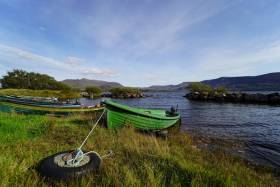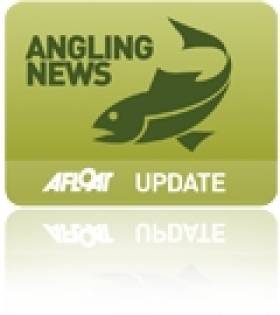Displaying items by tag: Lough Currane
Inland Fisheries Ireland (IFI) has recently commenced a comprehensive sea trout assessment and monitoring programme in the Lough Currane catchment in Kerry.
The project, called Currane STAMP, aims to identify potential factors contributing to the apparent decline of sea trout populations in the area in recent years.
It follows reports from anglers of reduced catches and is funded by IFI through its Salmon and Sea Trout Rehabilitation, Conservation and Protection Fund.
Sean Canney, Minister of State with responsibility for inland fisheries, said: “The Currane system is an internationally renowned angling hotspot for salmon and sea trout and hosts some of the longest lived and largest sea trout found in Ireland.
“However, recent indications from angler rod catch reports suggest declines in sea trout populations in the system and I support Inland Fisheries Ireland’s attempts to get to the bottom of these developments.”
The Currane project is one of 25 across 16 counties which have been awarded funding by IFI through its National Strategy for Angling Development.
The organisation today (Thursday 5 December) announced funding of €1 million for fisheries conservation, protection and education initiatives and for projects which will give the public greater access to fishing sites around the country.
In total, €242,900 has been awarded to the research project on the Currane — €55,800 in 2018 and a further €187,000 in this latest funding call.
A separate initiative at Scartleigh Weir near Listowel will also receive €6,000 to support the provision of CCTV equipment to monitor illegal poaching activity in the area.
As part of the programme on the Currane, researchers will use a combination of traditional and novel research techniques to examine important aspects of sea trout ecology throughout their life stages.
‘This project will help to answer key questions related to the apparent decline of trout in the area’
Habitat surveys will map important spawning and nursery areas while electrofishing (a benign technique used to catch fish by stunning them for a short period of time) will be conducted to assess juvenile fish population trends against previous studies in the area.
IFI researchers have already begun tracking the movement of juvenile sea trout tagged with tiny acoustic tags. Acoustic receivers, which record the movement of any tagged sea trout passing within range, have been strategically placed in freshwater in the Currane system and in the sea in Ballinskelligs Bay with a view to uncovering the freshwater movement and inshore migratory routes of sea trout and determining their survival in the marine environment.
The research will be co-ordinated and conducted from Met Éireann’s Valentia Observatory in Cahersiveen where IFI research officer Ryan Murray will be based and supported by experienced local fisheries staff.
In addition to the sea trout assessment, the team will also work on a salmon monitoring programme which will aim to determine if population trends between the two species are related or independent.
IFI’s head of R&D Dr Cathal Gallagher said: “This research will collect vital information on sea trout which will ultimately inform management strategies which may be required to combat the possible deterioration of sea trout in the Currane system. I would like to acknowledge the support of Met Éireann for this project and we look forward to working with local anglers on the ground to help establish the status of sea trout populations.”
As part of a citizen science initiative within the programme, IFI will be enlisting the invaluable knowledge and assistance of local anglers to establish current and historical rod catch trends.
Neil O’Shea, a fourth generation Currane ghillie who is supporting the programme, said: “I am looking forward to contributing to the sea trout citizen science component developed by Inland Fisheries Ireland. This project will be important for the sea trout fishery in Currane and will help to answer key questions related to the apparent decline of trout in the area.”
#ANGLING - The Irish Times' resident angling expert Derek Evans was on hand at the launch of Sea to Stream, a new film documenting the salmon and sea trout season on Lough Currane in Co Kerry.
The hour-long DVD follows anglers Richie Johnson and Charles Stewart on "a fishing journey" of the lough from the opening day of the fishing season in a fashion akin to their previous effort Follow the Fly in 2010.
Like that film, this one also features narration from noted actor Niall Tóibín (Ryan's Daughter, Ballykissangel), and includes "compelling" photography by cameraman Gary Finnegan.
The action isn't just confined to Lough Currane, however, as Johnson and Stewart also attempt fly fishing in the nearby River Inny and angle for trout on Lough Namona.
The Irish Times has more on the story HERE.
Three Opportunities for Lakeside Living
#WATERFRONT PROPERTY - The Irish Times features a selection of serene lakeside properties to suit a variety of tastes and budgets.
Urrahill in Ballycommon, Nenagh, Co Tipperary is a detached home overlooking Luska Bay and Lough Derg and comprising three levels.
The upper level features living rooms and a kitchen with large windows and stunning views. The middle level has four bedrooms, with the main en-suite on the lowest floor with sliding doors to a private terrace.
Colliers International is asking €1.5 million for this ultra-modern property.
Meanwhile in Kerry, a four-bed country house on 1.5 acres is less than a mile from Waterville yet features its own pier with boathouse on Lough Currane, known for its salmon and trout angling.
The house has central heating throughout, oak flooring, a lounge with its own wood-burning stove, a fully fitted kitchen, car garage and utility shed. Kerry Property Services is asking €580,000.
Last but not least, those looking to renovate would surely be attracted to Eden Point in Rossinver, Co Leitrim, a two-bed, two-bathroom detached home on the shores of Lough Melvin.
Eden Point boasts "hundreds of metres" of foreshore, as well as a boat house and quay, and included in the sale is a share in the Rossinver Fishery Sundicate (worth €5,000) which allows free use of the Rossinver Fishery. Fermanagh Lakeland Properties is asking €250,000.































































